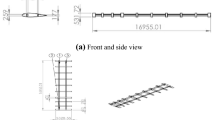Abstract
Multi-body simulation (MBS) plays an important role today in design and optimisation of modern valve trains. In view of more stringent engine-speed requirements, it is necessary to detect excessive increases in mechanical loads as the result of resonance at an early time and avoid it in the test engine even before implementation. The valve spring plays a central role in the sector of valvetrain dynamics. Within a valve train, the spring is the component, which has by far the lowest natural frequency and it consequently plays a crucial role in determining the dynamic behaviour. Owing to weaknesses in the commercially available spring model calculation methods, BMW has developed its own computing model and has verified it on the basis of measurements.
Similar content being viewed by others
Rights and permissions
About this article
Cite this article
Flenker, C., Uphoff, U. Efficient valve-spring modelling with MBS valve-train design. MTZ Worldw 66, 6–8 (2005). https://doi.org/10.1007/BF03227805
Issue Date:
DOI: https://doi.org/10.1007/BF03227805




